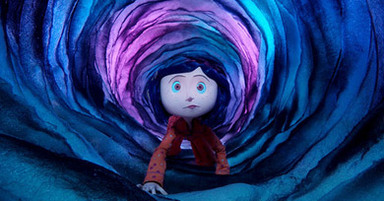
Henry Selick, despite being one of the most prominent stop-motion directors working today, is a name that most won’t know. Not only has he directed some of the most successful stop-motion films of recent years but has been instrumental in keeping the rare and pain staking art form from becoming obsolete. His work ranges from back in the 1980’s when he did work in commercials, moving into short films and eventually directing feature length stop-motion features. He’s since gone on to produce more successful feature length animations. Despite this prestigious body of work his name is sometimes overlooked. Here we look at the history and work of unsung hero Mr Henry Selick.

While at Disney, Selick met many young animators that were destined for future fame. He trained and worked on such classics as, The Fox and The Hound. He was also lucky to worked under such Disney legends as Glen Keane as well as his mentor Eric Larson.
While Selick was at Disney he received a grant from The American Institute of Film to direct an experimental short film called, Seepage. The film mixed life sized cut outs with stop-motion figures to create a surreal and vintage looking piece. The film won awards for its inventiveness but never made its way into the mainstream.

With the praise he received from MTV for his commercials he wrote, designed and directed a half hour pilot episode for a show called, Slow Bob in the Lower Dimsension. The show was once again experimental in its mix of stop-motion, live action as well as cut outs. Selick had intended to make a whole series when he received an offer that he simply couldn’t refuse.
Selick’s work attracted the attention of a fellow animator that he had known from both CalArts as well as Disney, Tim Burton. Once Burton had achieved success with his Batman film he remembered a short story he had written as a Disney animator. After lengthy negotiations Disney agreed to finance and produce, The Nightmare Before Christmas. This would mark the first full length stop-motion feature by an American company although Disney put the film under its Touchstone label fearing the project would be ‘too dark’ for children.

He personally chose Selick to direct the film as it was he who Burton had shown his original sketches of the project too while at Disney. Burton also recognised that Selick was the front running in keeping stop-motion afloat in the United States. With his young student projects as well as his commercials for MTV, Burton recognised Selick as a true stop-motion artist. Selick assembled an expert team and began making Nightmare in July 1991.
The film opened on Halloween in 1993 and made $51 dollars in its theatrical run. Disney misperceived the film as too dark for children and family audiences as the film was considered a financial and critical success. This success was a mere fraction of what the film would go on to accomplish. The film has since gained cult status, been released annually at Halloween with a 3D re-released in 2003 as well as Disney chosing to move the film under it main Disney banner.
With the success of the film fans praised it as a wonder to Burton’s genius. The film was released under, Tim Burtons The Nightmare Before Christmas, as Disney hoped the name would attract audiences. This sadly overshadowed Selick’s hard work. The ideas and characters are indeed born from Burton’s imagination but the style and animation is Selick’s hard graft. Selick is the director who dedicated three years of his life to making the film.
Despite Burton’s deep involvement in production had he directed, the film would be different. A director trade mark of Burton is the contrast of two opposing worlds. This is seen in Halloween and Christmas Town but usually Burton shows the underworld (Halloween or the land of the dead) as being more bright and vibrant than the land of the living. This is cleary seen in Corpse Bride that Burton later went on to direct. Selick, although not showing Halloween as boring or dull, reserves the brightest colours and flashing lights for Christmas Town; had Burton directed this may not have been the case. Also while Burton chooses to mix stop-motion with CGI for a slicker look Selick keeps his animation much closer to its purest form. The film is credited to Burton’s body of work and Selick is sadly unsung in the phenomena that is Nightmare Before Christmas.

The story follows a young boy called James who loses his loving parents and is forced to live with his neglectful aunts. When James enters an overgrown peach that has grown in his aunts garden he meets a group of bugs that share his desire to escape their sad existence.The film mixed live action with stop-motion to create a dream like world for James to enter.
Despite the film receiving critical praise it performed poorly at the box office and was seen by Disney as a failure. This meant that Selick had little chance of receiving financial backing from Disney on future projects.

With the idea to re-invigorate stop-motion animation a new company was formed through the investment of Nike founder Phil Knight and the administration of Will Vinton studios. The company’s aim was to develop stop-motion animated feature films for family audiences. The company, Laika, brought in Selick as creative director and allowed him to direct a short project called ‘Moongirl’. The project was an eight minute short CGI animation to advertise the new studio. The acclaim of Moongirl lead to Selick being chosen as the director of Laika’s first full length feature film ‘Coraline’.
Beginning production in 2005 Coraline, based on Neil Gaiman’s best selling novel of the same name. It tells the story of young Coraline Jones and her desire to escape her mundane world. When she passes through a small door in her new home to the ‘other’ world its seems a perfect place accept all the inhabitants have buttons instead of eyes. She longs to stay with her ‘other mother’ but slowly relises this perfect world is not all it seems.
Selick not only directed the film but rewrote the screenplay for the film. Being completely faithful to Gaiman’s original novel would have produced a forty five minute feature which Selick expanded with Gaiman’s approval. The film again shows Selick’s signature stop-motion static style.

The film opened in 2009 and was considered a commercial and financial success. Despite this success Selick was unable to re-negotiate his contract with Laika and departed later that year. Laika has since gone on to make Paranorman and the up and coming Boxtrolls.
Despite his lack of praise Selick has an impressive legacy. His dedication to stop-motion has help preserve and protect the art form for future generations of animators as well as audiences. The future does seem bright for Selick. Having secured a four picture deal with Disney to produced scary stop-motion features intended for children. His next project will be, The Shadow King, intended for a delayed release next year. As well as another collaboration with Neil Gaiman, on his short story The Graveyard Book.
Whether all four of these are stop-motion or not, his work in the field is inspirational.
His fans can only hope that soon he will receive the praise and creative backing he so fully deserves.
We're celebrating 20 Years of The Nightmare Before Christmas! Keep in tune for more!

 RSS Feed
RSS Feed
